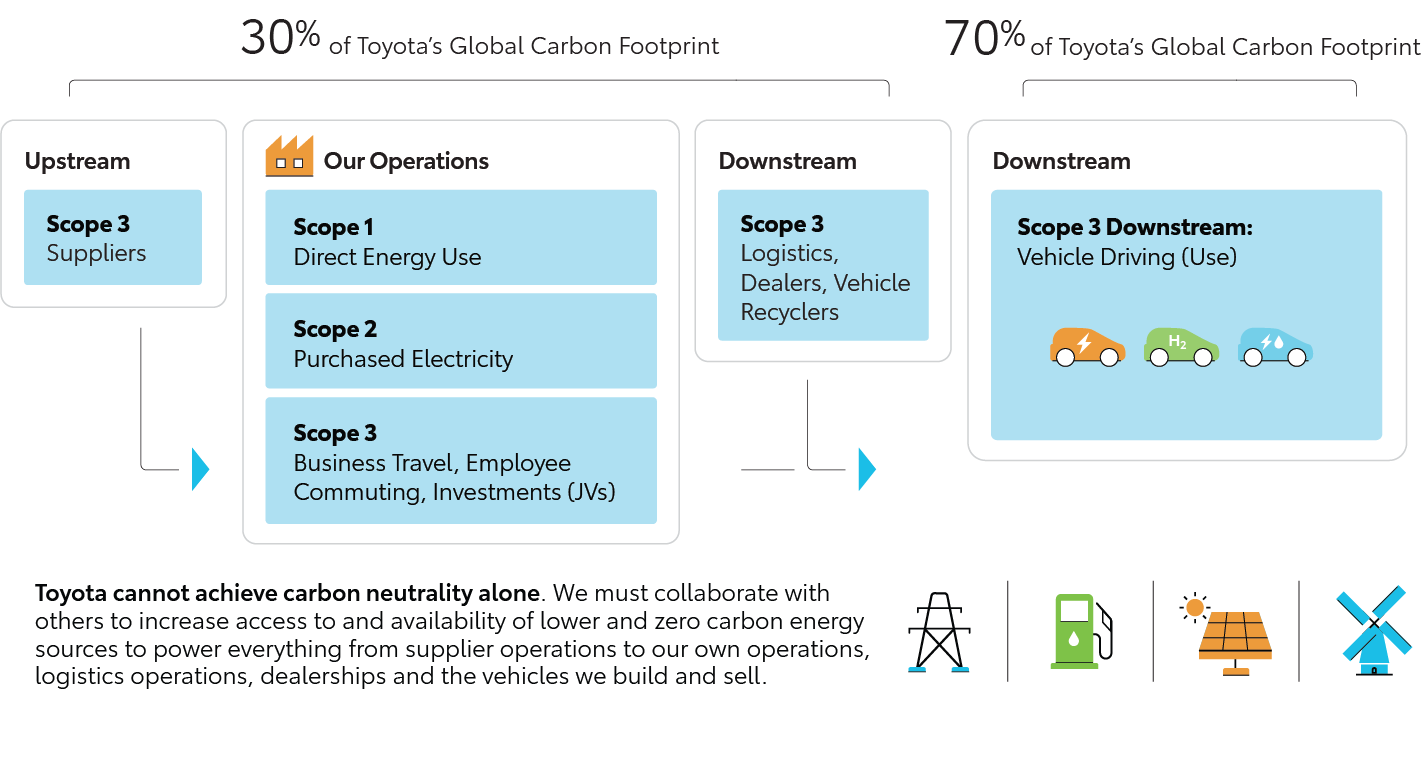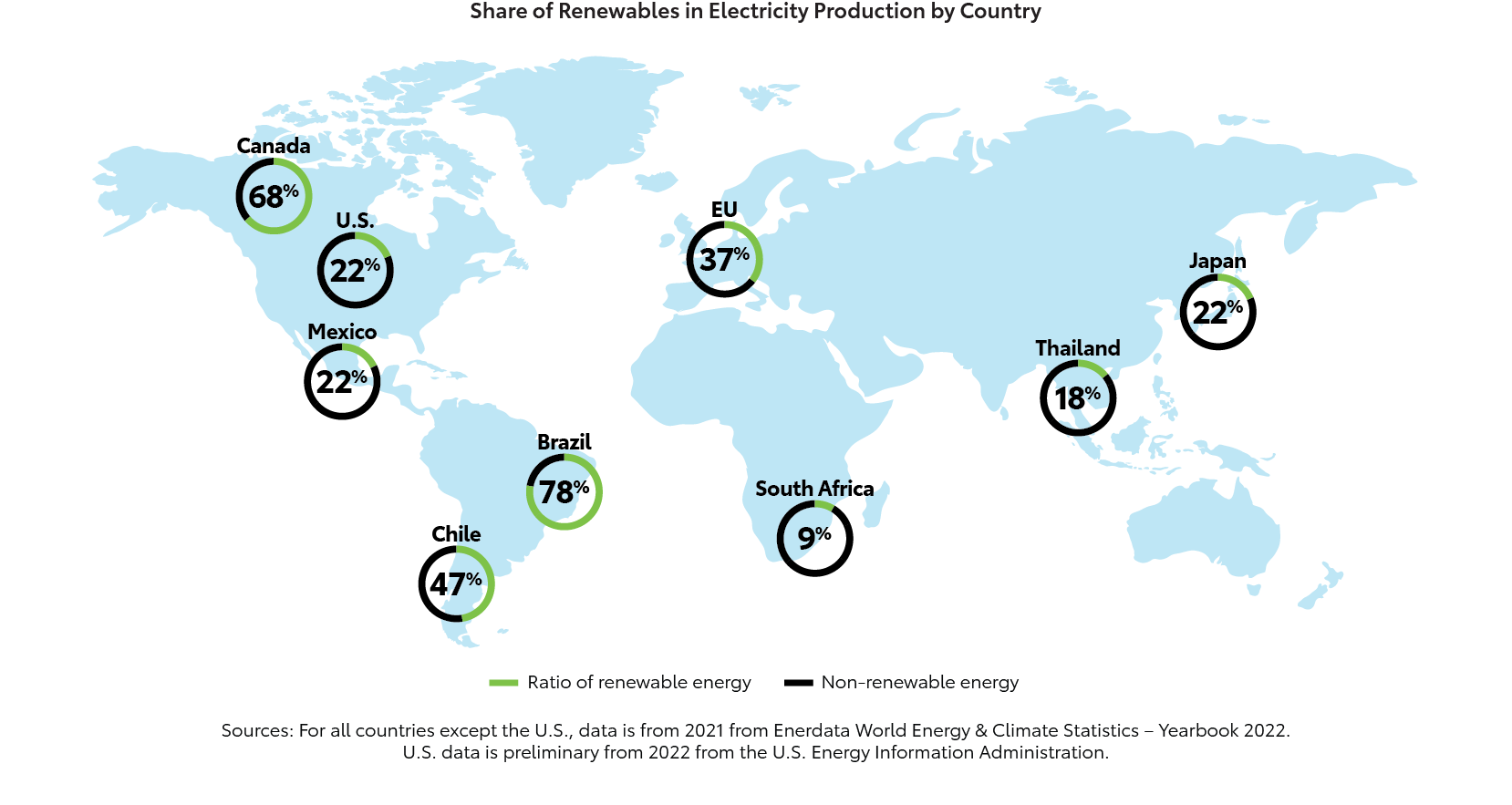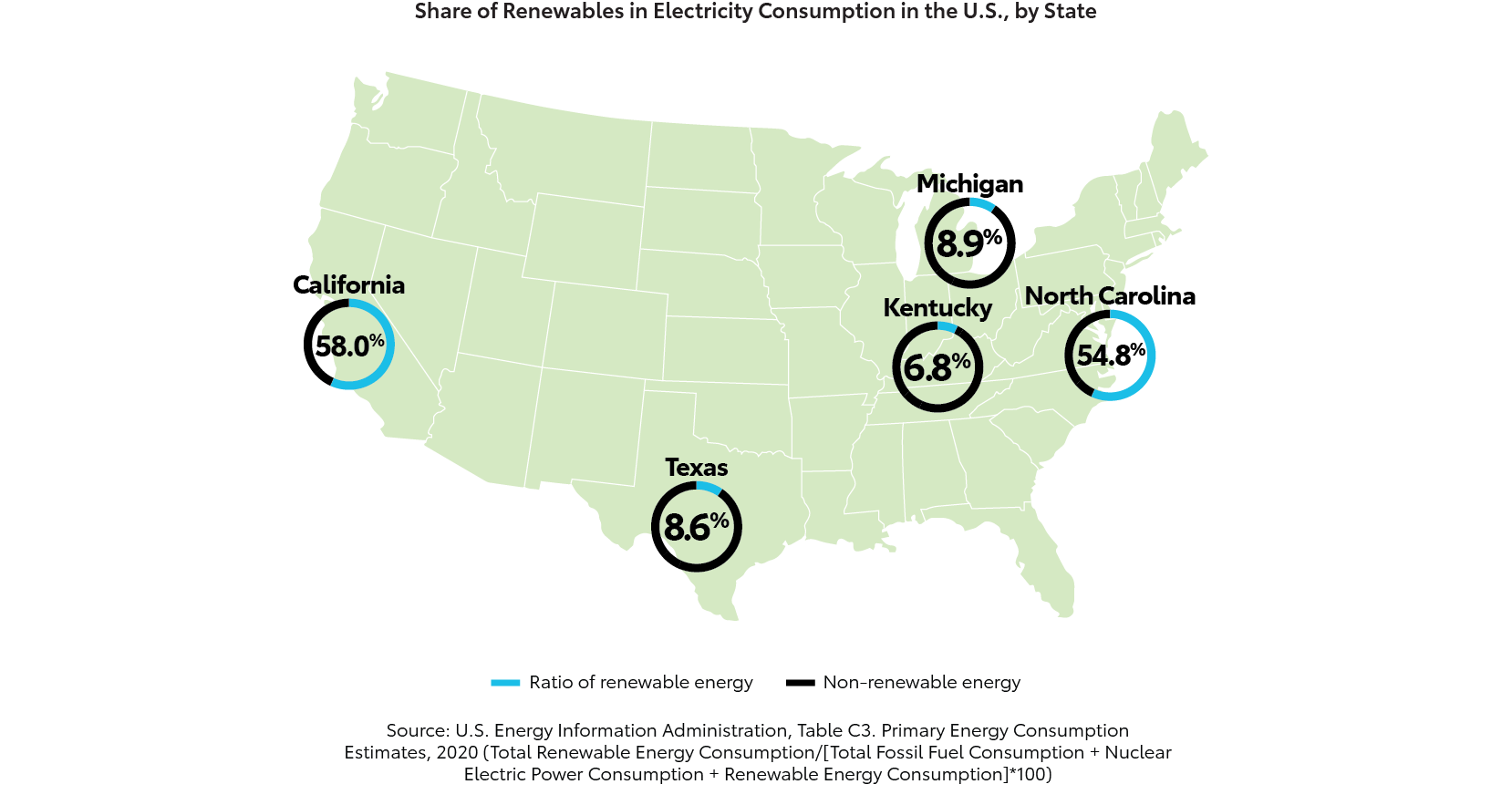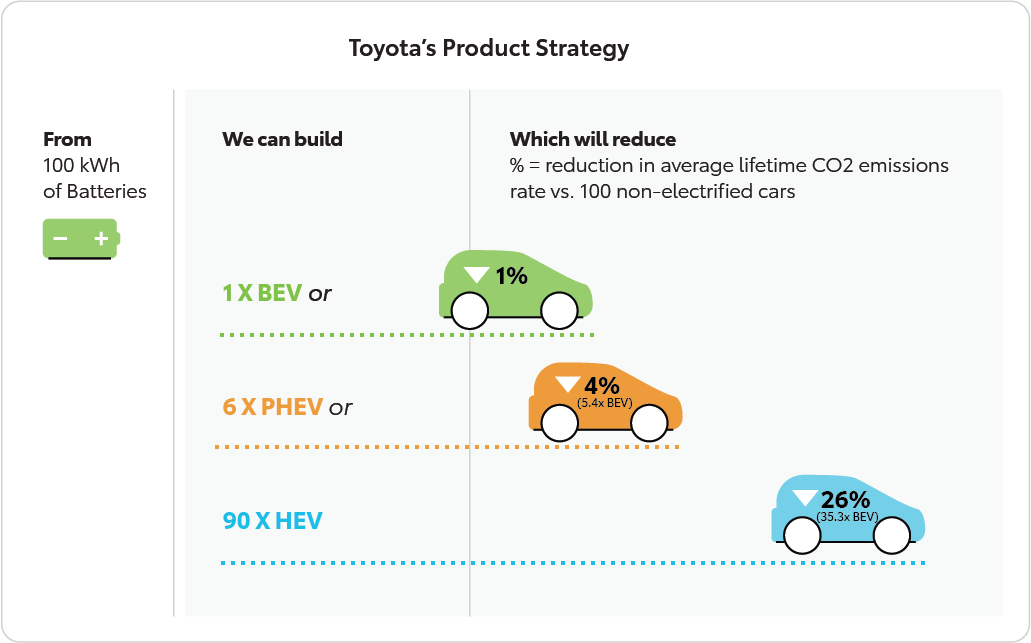Our Path to Carbon Neutrality
Climate change is real and it’s causing widespread concern.
Climate change, including the potential for more frequent and intense natural disasters, heat waves and droughts, is real. It is already impacting nature and people, beyond natural climate variability.1
To reduce the negative impact of climate change, global efforts are focused on reducing emissions of greenhouse gases (GHGs), which trap heat in the Earth’s atmosphere and cause changes to weather patterns. In 2015, 196 countries adopted the Paris Climate Agreement and committed to reducing GHG emissions in order to keep warming well below 2° Celsius, and to pursue efforts to limit warming to 1.5° Celsius.
To help ensure the goal of the Paris Climate Agreement is met, policymakers in some markets are setting climate change emissions reduction targets backed by new legislation. In many cases, these targets focus specifically on transportation, since the transport sector is reportedly responsible for about 37% of the world's GHG emissions2, with more than 40% of these emissions coming from passenger vehicles.3 In 2020, 3 billion metric tons of CO2 emissions were estimated to have been produced by passenger cars worldwide.4
The U.S. EPA estimates that in the U.S., transportation is responsible for 27% of GHG emissions and 57% of these come from passenger cars.5 The Biden Administration has publicly committed to half of new vehicle sales in the U.S. to being zero-emissions vehicles (ZEVs) and building out a national network of 500,000 EV chargers by 2030.6 California will require all new vehicles sold in the state to be ZEVs by 2035.7 An additional 17 states have adopted or are poised to adopt these standards in whole or in part. These states represent more than 40% of the U.S. market.8
Canada has proposed a new regulation that would require 60% of all new vehicles to be ZEVs by 2030 and 100% by 2035.9
At the same time, there is increasing pressure on business to take action beyond what is dictated by policy. Consumers are increasingly concerned about climate change and the challenges future generations will face. The media reports on climate change more regularly and investors expect to see corporate climate change performance improve significantly in the near and medium term.

To minimize total accumulated GHG emissions in the atmosphere and mitigate the worst impacts of climate change, the world must lower GHG emissions as much as possible, as soon as possible.
The CO2 we emit today will remain in the atmosphere until the time of our great-grandchildren and future generations. That’s why Toyota is relentlessly focused on reducing carbon emissions across the entire vehicle life cycle as much as possible, as soon as possible - everywhere and for everyone.
Toyota is committed to becoming carbon neutral across the vehicle life cycle by 2050.
Carbon neutral means we aim to reduce and offset GHG emissions to achieve net zero carbon emissions across operations, manufacturing, logistics, use and recycling of our products, all by 2050.
We have set science-based targets validated by SBTi to help keep us on the right path to achieving carbon neutrality by 2050.

Globally, emissions from vehicles while driving comprise approximately 70% of Toyota’s carbon footprint over the life cycle, but we are not ignoring the other 30%.

Toyota has set mid-term goals for operations, suppliers, logistics and dealers that we believe put us on a path to achieving carbon neutrality by 2050.
Toyota aims to be carbon neutral at all global manufacturing facilities by 2035. We have a science-based target to reduce GHG emissions from our operations by at least 68% compared to 2019. In North America:
- We plan to match 45% of our purchased power with renewable electricity by 2026.
- We are exploring the electrification of our natural gas-fired equipment and the use of renewable natural gas and stationary hydrogen fuel cells to eliminate GHG emissions from manufacturing operations.
Globally, Toyota aims to reduce emissions from suppliers, logistics and dealers by 30% by 2030, compared to a 2019 baseline. In North America:
- By 2026, TMNA’s suppliers aim to reduce their CO2 emissions by 14% compared to FY2018 levels. Through the Green Supplier Requirements, we are asking suppliers to commit to a 3% per year reduction.
- By 2026, TMNA aims to reduce CO2 emissions from logistics activities by 15% compared to FY2018 levels.
- TMNA is encouraging dealerships to invest in renewable energy and invest in energy savings through our Dealership Environmental Excellence Program (DEEP).
To help reduce carbon emissions from driving our vehicles, our portfolio approach reduces emissions more than focusing on a single pathway.
Toyota believes battery electric vehicle (BEVs) and hydrogen fuel cell electric vehicles (FCEVs) are the future. These technologies can’t be adopted overnight, so during the transition, hybrids (HEVs), plug-ins (PHEVs) and vehicles that can run on lower carbon fuels are an important part of Toyota’s product strategy.
GLOBALLY |
IN NORTH AMERICA |
By 2025, we plan to have an electrified¹⁰ option available for every single one of our Toyota and Lexus models globally so that electrified vehicles are affordable and accessible to everyone. |
In the U.S., 52% of available Toyota and Lexus models have an electrified option. Toyota’s 22 electrified vehicles represent the largest breadth among all manufacturers in the U.S. with hybrid, plug-in hybrid electric, hydrogen fuel cell electric and battery electric vehicles. |
Toyota plans to launch a new dedicated BEV architecture and release 10 new BEVs by 2026, which amount to annual sales of 1.5 million vehicles. We aim to have 30 BEV models and expected annual sales of 3.5 million BEVs by 2030. That will be more than 1 in every 3 vehicles sold. |
In the U.S., Toyota’s sales of its electrified vehicle portfolio will increase to 40% of total vehicle sales (by unit) by 2026 and 70% by 2030 (excluding performance vehicles). |
Toyota intends to invest more than $70 billion in vehicle electrification through 2030. |
Part of this investment is for the new battery manufacturing plant in North Carolina, which is expected to open in 2025 with production lines for making batteries for both BEVS and HEVs/PHEVs. |
Toyota’s global target – validated by SBTi – is to reduce emissions from driving new passenger cars and light duty vehicles by 33.3% by 2030 and by more than 50% by 2035 (2019 baseline). |
In the U.S., we are on track to meeting this commitment. The U.S. EPA has released new vehicle GHG regulatory requirements that are expected to lead to a more than 33% reduction in vehicle GHG emissions, measured in grams CO2 per mile, by 2026. |
Toyota is investigating the feasibility of lower carbon fuels to power today’s vehicles while also continuing to develop hydrogen fuel cell vehicles. Toyota’s global target – validated by SBTi – is to reduce emissions from the use of sold medium and heavy freight trucks by 11.6% per vehicle kilometer by 2030 (2019 baseline). |
Starting in 2023, Toyota Kentucky plans to begin assembling integrated dual fuel cell modules destined for use in hydrogen-powered, heavy-duty commercial trucks. Initial customer deliveries are planned for 2024. |
Our vehicle electrification strategy addresses diverse needs and energy conditions in different regions.
Customer preferences have always been extremely important to Toyota. Toyota has the privilege of serving customers in approximately 200 countries and regions worldwide. And one thing we know is that different customers have very different needs. Toyota’s strategy fits diverse needs in different markets and recognizes there is no one-size-fits-all solution.
There is significant variance in country adoption rates of renewable energy.

And even within countries, there is significant variance in adoption rates of renewable energy. In the U.S., renewable energy is less than 7% of the electricity consumed in Kentucky, and 58% in California.

Selling BEVs where renewable energy is not available will not eliminate carbon emissions alone. In many markets, that’s why we believe the most effective way to reduce emissions is through multi-powertrain options – like hybrids, plug-in hybrids, and low carbon and carbon neutral fuel vehicles.
There is also significant variance in the number of EV charging stations available for public use. According to a report from the U.S. Department of Energy, the ideal ratio of EVs to charging stations is 40 Level 2 charging ports and 3.4 DC fast chargers (DCFC) per 1,000 EVs. California’s ratio is second to New Jersey’s, which is the only state in the U.S. that’s close to meeting this ideal with a ratio of 41.34 EVs to charger ports. Projections say that by 2030, the country will have 30 million EVs on its roads, and that would require the construction of 478 charger stalls per day for eight years in order to meet the need. 11
State¹² |
Total EVs |
Total Charging Ports |
Ratio: EVs to Charger Ports |
California |
930,811 |
34,185 |
27.23 |
Texas |
78,585 |
4,946 |
15.89 |
North Carolina |
32,782 |
2,287 |
14.33 |
Michigan |
31,753 |
1,642 |
19.34 |
Kentucky |
5,458 |
399 |
13.68 |
U.S. Total |
2,147,070 |
109,307 |
19.64 |
So, while we build up to having more BEVs on the road, in the meantime, an HEV might be the best way to reduce emissions if you regularly travel long distances in a market with limited charging infrastructure. If you only drive short distances every day, a PHEV might give you the same emission reduction as a BEV at a more affordable price. And as low carbon and carbon neutral fuels become more widespread, the best way to reduce emissions may be in a traditional car.
Our diverse powertrain strategy does more with less lithium.
We believe all-electric and hydrogen fuel cell electric vehicles are the future. We also know that hybrids, plug-ins, and low carbon fuel vehicles must be an essential part of Toyota’s product strategy. The reason is that there are significant resource constraints over the coming decades and that it is critical to make the most of scarce resources.
For example, lithium is one of the most important elements needed to create BEVs, and every manufacturer is working to secure supply. Unfortunately, there are limits to how much lithium is available. In fact, the international Energy Agency (IEA) believes that lithium mine expansion will only cover two-thirds of what will be needed in 2030.
Toyota’s strategy is designed to reduce emissions by as much as possible, as soon as possible. If we have 100 kWh of battery capacity, we have three choices about how to use that capacity:

These choices have an impact on emissions. If we use our limited supply of lithium to build 90 HEVs, the impact on emissions is dramatic: We can reduce fleet emissions by >26%. Even more importantly, our HEVs can reduce emissions in every market in the world, today.
Beyond passenger vehicles, Toyota’s hydrogen fuel cell technology has proven to be a viable option for heavy-duty trucking.
This electrified powertrain is powerful, versatile and scalable enough to be utilized across a range of vehicle types, serving multiple applications and industries. Best of all, these powertrains only emit water from the tailpipe.
Toyota recently collaborated with Kenworth in the U.S. to explore the fuel cell electric technology for heavy-duty truck applications. They built 10 FCEVs to support a proof-of-concept project, conducted in partnership with the Port of Los Angeles and Shell, and logged more than 60,000 miles during the project and testing. Toyota’s heavy-duty fuel cell electric powertrain kit was recently awarded the Zero Emission Powertrain certification by the California Air Resources Board (CARB). Following the completion of the successful collaboration, Toyota and PACCAR announced an expansion of their joint efforts to develop Kenworth and Peterbilt models powered by Toyota’s next-generation fuel cell modules. Initial customer deliveries are planned for 2024.
Heavy-duty trucks with fuel cells that run on clean hydrogen have the potential to make a significant dent in carbon emissions from trucking.
There is a lot to do between now and 2050 to achieve our goal of carbon neutrality, but we have already made significant progress. Click here to see what we’re doing to reduce emissions in every stage of the vehicle life cycle.
[1] Synthesis Report of the IPCC Sixth Assessment Report (AR6), Summary for Policymakers, A.1 and A.2
[2] IEA, Transport: Improving the sustainability of passenger and freight transport
[3] IEA, Global CO2 emissions in transport by mode in the Sustainable Development Scenario, 2000-2070
[4] IEA, Global CO2 emissions in transport by mode in the Sustainable Development Scenario, 2000-2070
[5] U.S. EPA, Fast Facts on Transportation Greenhouse Gas Emissions
[6] White House Fact Sheet: Biden-Harris Administration Announces New Standards and Major Progress for a Made-in-America National Network of Electric Vehicle Chargers, Feb. 15, 2023
[7] California moves to accelerate to 100% new zero-emission vehicle sales by 2035, Aug. 25, 2022
[8] States that have Adopted California’s Vehicle Standards under Section 177 of the Federal Clean Air Act, May 13, 2022
[9] Canada Gazette, Part I, Volume 156, Number 53: Regulations Amending the Passenger Automobile and Light Truck Greenhouse Gas Emission Regulations, Dec. 31, 2022
[10] An electrified vehicle refers to a range of technologies that use electricity to propel a vehicle, including Hybrid Electric Vehicles (HEVs), Plug-in Hybrid Electric Vehicles (PHEVs), Battery Electric Vehicles (BEVs) and Fuel Cell Electric Vehicles (FCEVs).
[12] Data as of Sept. 2021. https://evadoption.com/ev-charging-stations-statistics/charging-stations-by-state/



